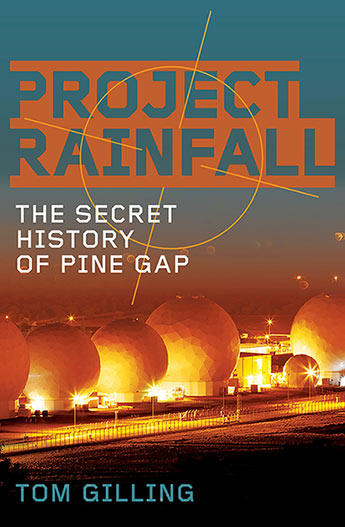
Project Rainfall. By Tom Gilling. Allen and Unwin, Sydney 2019.
Reviewed by Mark Edmonds
Writing credible books and articles about national security and classified intelligence matters is complicated at the best of times. While sometimes there may be an abundance of material, such as in the case of the Joint Defence Facility Pine Gap, evaluating and contextualising it can be problematic.
Unauthorised disclosures (including those from government sources) is rarely free of some form of contamination, including personal or ideological grievances. And given the nature of the intelligence community, information is necessarily compartmentalised. Even accidental disclosures – dossiers left in hotel lobbies or filing cabinets that had not been properly sanitised before being disposed of – may not always give a prospective author “the big picture”.
Moreover, and perhaps in some part because of this, the subject of national security and intelligence is tantalising; it leaves room for speculation and the introduction of political or other agendas to explain outwardly observable actions, free of the data needed to be confident of the conclusions that authors have written.
Into this environment Tom Gilling has presented his latest work, “Project Rainfall: The Secret History of Pine Gap”. Gilling, primarily a novelist, is not an immediately obvious source for a book on the Australian Intelligence Community. And yet he has prepared what is undoubtedly the best written and most nuanced work on the JDF at Pine Gap. Gilling’s strengths lie in his ability to describe how the evolution of science and technology in the 1950s, particularly in space based surveillance, drove the requirement for a site like Pine Gap, and how this requirement was debated (and then met) in a Cold War and domestic political context. This blend provides the best explanation for why and how the Pine Gap site came into existence, as well as how public discourse around the site has evolved over time.
The book relies on a wide range of sources, including recently declassified material, unauthorised disclosures and secondary sources. It is thoroughly well researched but disappointingly, the lack of footnotes (there is an extensive bibliography), make referencing and source checking difficult. This appears to be a modern trend in “popular” non-fiction writing but can be frustrating for those seeking to explore further specific information referred to by authors.
There is, in a sense, very little “new”, in this book. Its strength is rather the amalgamation of science and technology with the geo-political context in which the Rainfall concept came about. The author describes the evolution of operations at the site over the past thirty years in particular, again placing this evolution into the correct geo-political context, including capturing Rainfall’s role in strategic arms limitation testing, the middle eastern conflicts, and the “Global War on Terror”. Gilling does this without falling into the temptation of elevating salacious insights disclosed by disgruntled employees, or the speculative indignation of (usually left leaning) political ideologues. What results is a well-balanced, insightful and thorough history of the facilities at Pine Gap, complete with a charming chapter on UFOs!
While Gilling does an creditable job of tracking the evolution of the facilities in the context of Australia’s relationship with the US, and in particular other joint or US only facilities on Australia soil (undertaking such activities as military communications, weapons testing, space research, etc), it does fall short in evaluating Rainfall’s role in Australia’s overall intelligence collection capability. Criticism of Rainfall, such as that from former academic and writer Des Ball, has tended to question whether the benefits Australia receives from the site are worth the risk of being a target, or compromising national sovereignty. However, this question can only be fully understood, especially in the absence of access to actual Rainfall intelligence product, in the context of other intelligence collection sources and methods and Australia’s overarching defence and security objectives. A broader understanding of Rainfall’s role in the Australian SIGINT Organisation and Australia’s regional surveillance capability (such as the Jindalee Over the Horizon Radar (JORN) or the RAN submarine force) would have been helpful, even if difficult to provide.
Notwithstanding, Project Rainfall is without question one of the best texts written about the Pine Gap Joint Defence Facility. It provides excellent historical and technological context, is relatively devoid of ideological bias and is well written and engaging. Any student of the Australian Intelligence Community should ensure this book is included in their library.



